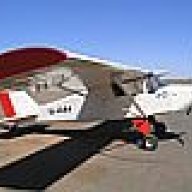Simple V complex?
Gooday again from a close neighbour (give me a ring sometime!)
Having been through this decision, my answer was the KISS principle. Having fitted
after-market VDO fuel gauges to auxilliary tanks in various 4WD's, the calibration process and the lack of consistent readings made me question the reliability of this process.
On the BC I chose to use a sight gauge on each wing tank, with the proviso that there is a restrictor in the tube to dampen the effect of surging. It is then very easy to calibrate - with the airframe propped up in level flying attitude, add a measured 5 litres at a time to the tank and mark the level on a paper temporary scale behind the sight tube. When finished, get an engraved plastic scale made. No problems with linearity, accurately calibrated for your particular tank shape, no moving parts, no electrical requirements, easy to establish unusable fuel quantity, easy to read with a contrasting background colour, etc.
Remember that whether you use a float gauge or a capacitive gauge, there is no surge damping and the readings will wander according to attitude.
How's that for an opinion?


